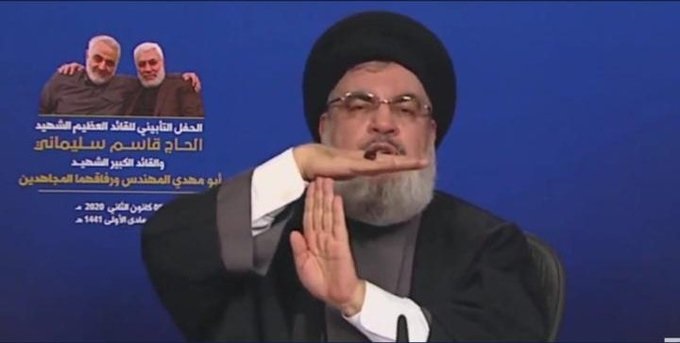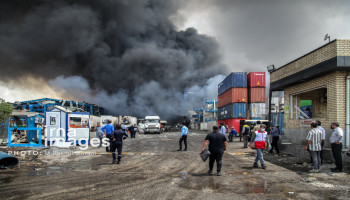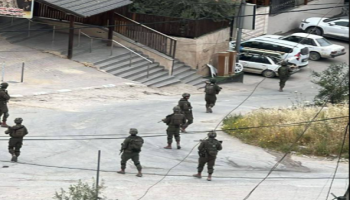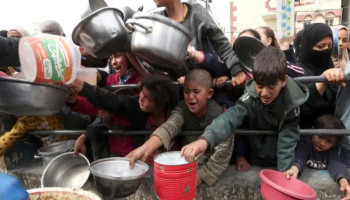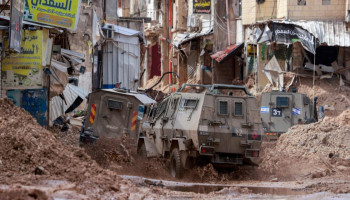Following the heinous crime perpetrated by the Zionist enemy—the assassination of Hezbollah's Secretary-General, Sayyid Hassan Nasrallah—the enemy became blinded by arrogance. This delusion led them to boast of their intent to decisively invade Lebanon by land, believing that by targeting Sayyid Hassan Nasrallah, they had shattered Hezbollah, the primary obstacle to their ambitions in the region. Confident that the field was now clear, and that Hezbollah’s structure had collapsed, the Zionist forces advanced toward Lebanon, hoping for a swift victory.
However, their delusions were quickly shattered. At the borders of Lebanon, where they anticipated little resistance, they were met with the formidable force of Hezbollah's fighters. In the initial stages of their advance, the Israeli military suffered a devastating blow, a humiliation that Israeli media labeled a catastrophe, one that left the enemy in shock.
The martyrdom of Sayyid Hassan Nasrallah did not weaken Hezbollah’s resolve. On the contrary, the fighters of the Islamic Resistance, fortified by their unwavering dedication to their sacred duties, continued their struggle with even greater determination. Now more emboldened than ever, they pursued the Israeli enemy with a renewed fervor, eager for confrontation.
This was evident in the heroic and precise operations that unfolded as the resistance thwarted multiple attempts by Israeli forces to advance on different fronts over the past two days.
“We Answer Your Call, O Nasrallah!”
In the early hours of Tuesday, October 1st, 2024, the village of Aadaysit on the Lebanese-Palestinian border seemed tranquil. Yet beneath this calm, the vigilant eyes of the Islamic Resistance were tracking the reconnaissance movements of the Israeli enemy. The fighters did not engage the scouting party but allowed it to complete its mission, knowing it was bait for a larger force.
By the next morning, Wednesday, October 2nd, an elite Israeli unit comprising over 30 officers and soldiers silently infiltrated the ambush zone. The stillness was shattered by the cry, “We answer your call, O Nasrallah!” From that moment, the sky erupted with bullets and rocket fire.
The close-quarters battle was fierce, inflicting heavy casualties among the Israeli infiltrators. Their desperate cries for help echoed as nearby Hezbollah support units targeted enemy supply lines in Misgav Am, Kfar Giladi, and Metula, preventing reinforcements from reaching the besieged force.
Israeli helicopters arrived to evacuate the dead and wounded, but Hezbollah had already completed its mission. More than 80 Israeli soldiers, including officers, were killed or wounded, and five Merkava tanks were destroyed, as confirmed by the enemy’s military reports.
Meanwhile, chaos spread at Ben Gurion Airport, with hundreds of Israelis stranded after numerous airlines canceled flights, adding to panic and disarray.
The resistance against Israeli forces wasn’t limited to the elite units infiltrating southern Lebanese villages, but extended across the border, into Israeli military outposts, orchards, and positions within the occupied territories. All Israeli military build-ups gathered at the Lebanese-Palestinian border within the Islamic resistance's range, were engaged with the appropriate weapons.
The outcome on that front was clear: any elite Israeli force that dared to enter was either killed, wounded, or forced to retreat in humiliation.
The pain inflicted by Hezbollah was underscored by reports from the New York Times, which quoted Israeli officials admitting that deploying a fifth division to the Lebanese border signaled a difficult battle against a highly capable adversary.
Similarly, Zionist Yedioth Ahronoth newspaper reported that Israeli Egoz commandos narrowly prevented Hezbollah from capturing a soldier’s body, underscoring the dire circumstances the infiltrators faced in close combat.
The Bloody Wednesday
Maroun al-Ras became another site of humiliation for the Israeli forces. An Israeli unit attempted to infiltrate the village from the east but was met with high readiness from Hezbollah fighters, resulting in numerous enemy casualties and the destruction of three Merkava tanks by guided missiles. Later, another Israeli force tried to advance east of Maroun al-Ras but was hammered by Hezbollah’s rocket and machine gun fire.
In Yaron, an Israeli infantry unit attempted to maneuver through the forest but was ambushed by Hezbollah with a special explosive, leaving the soldiers dead or wounded.
The string of Israeli miscalculations continued as another infantry unit tried to take cover in a house on the outskirts of Kfarkela. Hezbollah fighters detonated a pre-planted explosive before unleashing a barrage of rocket fire and machine-gun rounds, leaving the unit in disarray.
The Zionist military announced the death of a captain from the 202nd Paratrooper Battalion during the clashes on the Lebanese border on Wednesday. Israeli media later confirmed that the officer was killed in a separate battle from the battle that of the eight other soldiers.
Meanwhile, Hezbollah’s rocket forces continued to provide vital support, executing 19 missile strikes on Israeli forces concentrated between Misgav Am, Kfar Giladi, and Metula’s orchards, achieving direct hits on enemy positions.
Hezbollah rockets also struck deep into Israel, hitting (Amiad base, Adamit settlement, areas near Haifa, Avivim, and others, while a drone swarm targeted Israeli artillery positions in Naveh Ziv.
Support Beyond Borders
Hezbollah is not alone in confronting the Zionist entity. The entire Resistance Axis joined the battle. Islamic resistance in Iraq launched three separate attacks inside Israel using advanced "Araqab" cruise missiles. The Yemeni Armed Forces also struck occupied Yaffa and Umm al-Rashrash with drones, successfully hitting their targets. Zionist media reported the firing of a hypersonic missile from Yemen toward the Gush Dan area, causing over 1.5 million settlers to flee to shelters.
The most significant escalation came from the Islamic Republic of Iran, which launched a barrage of approximately 180 hypersonic missiles targeting Israeli military bases in retaliation for the assassination of Sayyid Hassan Nasrallah. The missiles struck Hatzor, Nevatim, and Ramon airbases, causing extensive damage to Israeli military infrastructure.
Merkava and Namera in the Crosshairs
As the confrontation intensified in southern Lebanon, Israeli forces admitted that their airbases sustained heavy damage from Iranian missile strikes. Israeli media reluctantly acknowledged the destruction of key infrastructure, including warplane maintenance facilities, following a cover-up attempt.
Hezbollah’s military media released footage showing the destruction of Israeli Merkava and Namera tanks at the Ruwaisat al-Alam site in the occupied Kfarchouba hills, marking a significant escalation in the conflict.
U.S. media outlet CNN confirmed the accuracy of these attacks, analyzing footage that showed missile impacts near Israeli intelligence and air force facilities, including the Mossad headquarters and Nevatim airbase in the al-Naqab.
Day Two of Humiliation
On October 3rd, Hezbollah continued to strike any Israeli forces attempting to advance into Lebanese territory for a second consecutive day. The Islamic Resistance’s operations room confirmed that, by Thursday afternoon, 17 Israeli soldiers, including officers, had been killed during the clashes.
A Hezbollah source informed Al-Manar that the fighters, using a variety of weapons and explosives, were repelling Israeli attempts to advance on multiple fronts, inflicting heavy losses on the enemy. The resistance’s rocket and artillery fire targeted Israeli positions and troop concentrations inside the occupied territories, halting any progress.
In Maroun al-Ras and Yaroun, Hezbollah detonated four additional explosive devices on advancing Israeli forces, causing severe casualties. A Golani Brigade unit attempting to flank Maroun al-Ras was decimated by Hezbollah’s ambushes.
Elsewhere, Hezbollah fighters destroyed a Merkava tank with a guided missile in the Natua settlement, while artillery fire rained down on Israeli forces attempting to push through at the Fatima Gate.
Rocket Barrages
In support of the fighters, Hezbollah unleashed a barrage of rockets targeting various Israeli settlements and military sites, including Tiberias, Safed, Amiad base, Misgav Am, Avivim, and many others. Precision strikes with Burkan and Falaq rockets also hit troop concentrations and military infrastructure, causing further chaos and devastation.
The Enemy Admits: We Are Sinking in the Quagmire
Israeli media, acknowledging the dire situation, began referring to the “Lebanese quagmire” the army had fallen into, predicting a long and grueling battle.
In an analysis aired on Israeli Kan TV, retired enemy generals admitted that Israel’s military was repeating the mistakes of the 2006 Lebanon War. They pointed out the army’s lack of preparation, poor intelligence, and inadequate combat strategy, and warned of heavy losses.
Where they also highlighted the logistical challenges faced by the entity in southern Lebanon, with the channel predicting a drawn-out conflict that would exact a high toll on the Zionist military.
Zionist military officials finally conceded the deaths of two more soldiers from the Golani Brigade on Thursday, raising the official death toll from clashes with Hezbollah to 10 officers and soldiers, with many others wounded.
Conclusion
The Israeli enemy must come to terms with the fact that its objectives—whether in assassinating Hezbollah’s leadership or dismantling the Resistance—will never be realized. Hezbollah’s structure, its unity, and its will to resist remain unbroken. Sayyid Hassan Nasrallah’s legacy,( may Allah's pleasure be upon him) his leadership, and the victories he promised continue to guide the fighters, who now declare: “As you always promised us victory, we promise you victory again.”
This message is clear to Israel, the United States, and all their allies: Hezbollah remains resolute, the Resistance is unwavering, and their defeat is inevitable.

